As we age, our skin undergoes significant changes, especially during menopause. The hormonal shifts can leave once-supple skin feeling dry, irritated, and in need of extra care.
But there’s no need to worry, creating your own custom facial oil can help address these concerns and give your skin the nourishment it craves.
Understanding Menopausal Skin Changes
During menopause, estrogen levels decline, leading to decreased collagen and elastin production. This results in increased dryness, fine lines, and loss of firmness.
The skin’s barrier function may also become compromised, making it more susceptible to irritation and environmental stressors.
These changes call for a skincare routine focused on intense hydration, nourishment, and protection. Facial oils are an excellent solution because they mimic the skin’s natural sebum, helping to restore balance and provide deep, lasting moisture.
The Importance of Facial Oils
Facial oils have been used for centuries in various cultures for their beautifying and healing properties. They’re packed with essential fatty acids, vitamins, and antioxidants that can help address many skin concerns associated with menopause.
Deep Hydration
Oils penetrate deeply into the skin, providing long-lasting moisture. This is especially beneficial for menopausal skin, which tends to be drier because of decreased oil production.
Barrier Protection
A strong skin barrier is crucial for maintaining hydration and protecting against environmental damage. Facial oils help strengthen this natural barrier, reducing water loss and shielding the skin from external stressors.
Anti-Aging Properties
Many oils contain potent antioxidants that fight free radicals, which are responsible for premature aging. Some oils also promote collagen production, helping to maintain skin elasticity and firmness.
Soothing Effects
Certain oils have anti-inflammatory properties that can calm irritated skin. This is particularly helpful for menopausal women who may experience increased skin sensitivity.
Balancing
Contra to what a lot of people believe, the right oils can help balance oily and combination skin types as well. By providing adequate hydration, they can actually help regulate oil production.
Choosing Your Base Oils
The foundation of your facial oil blend will be carrier oils. These are typically cold-pressed oils derived from the fatty portions of plants.
Here are some excellent options for menopausal skin:
Jojoba Oil
Jojoba oil closely resembles our skin’s natural sebum, making it easily absorbed and non-greasy. It’s rich in vitamin E and can help regulate oil production.
This oil is an excellent choice for all skin types, including sensitive and acne-prone skin.
Try this product from Amazon: Handcraft Blends Jojoba Oil
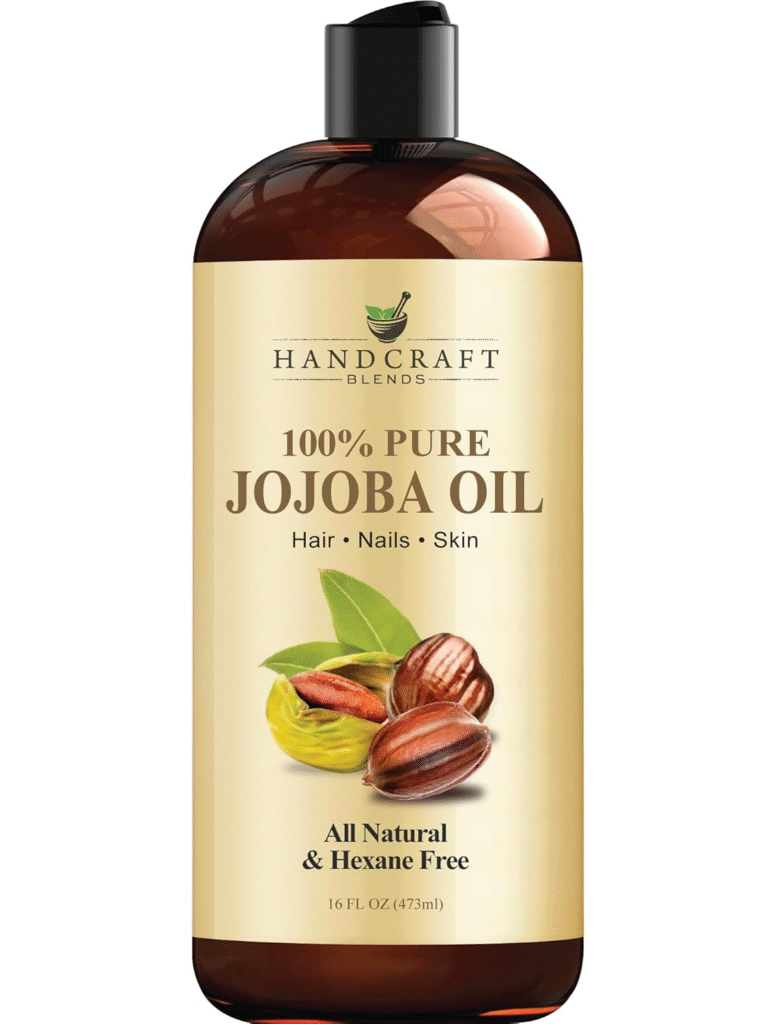
Rosehip Seed Oil
Packed with vitamin C and essential fatty acids, rosehip oil is excellent for promoting collagen production and reducing the appearance of fine lines and age spots. It’s also known for its ability to improve skin texture and tone.
Try this product from Amazon: SVA Rosehip Seed Oil
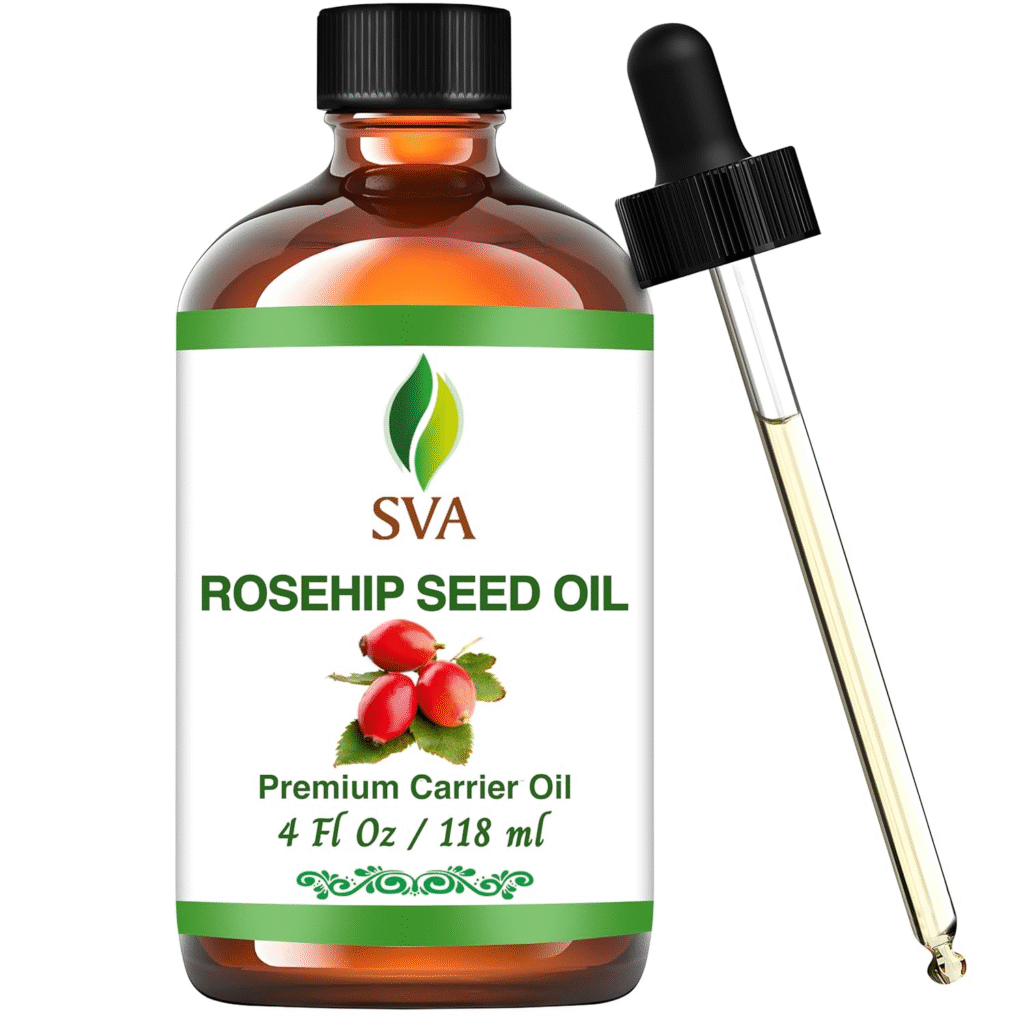
Argan Oil
This Moroccan oil is rich in vitamin E and fatty acids. It’s known for its ability to improve skin elasticity and provide deep hydration.
Argan oil is also non-comedogenic, meaning it won’t clog pores.
Try this product on Amazon: PURA D’OR 4 Oz ORGANIC Moroccan Argan Oil
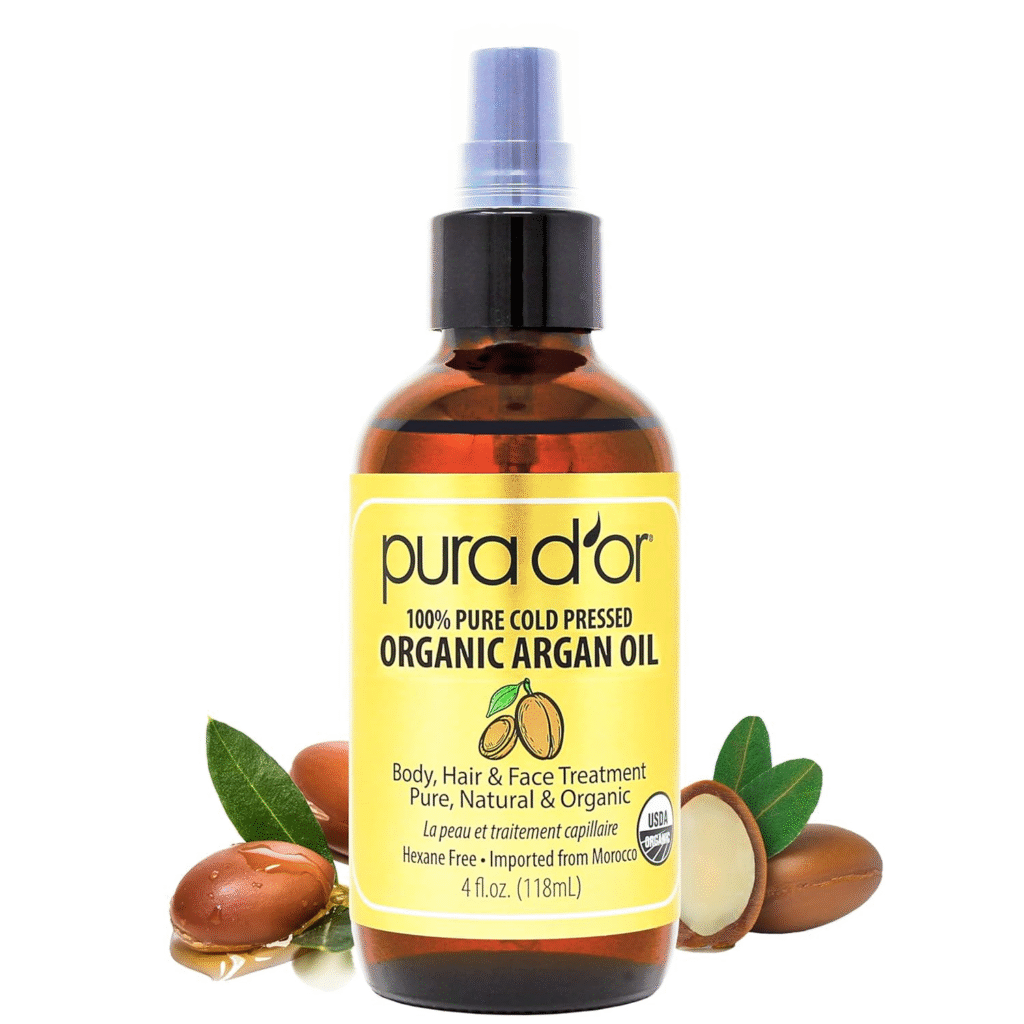
Evening Primrose Oil
High in gamma-linolenic acid (GLA), this oil can help improve skin elasticity and address hormonal imbalances in the skin. It’s particularly beneficial for those experiencing dryness and inflammation during menopause.
Try this product from Amazon: NatureBell Evening Primrose Oil with Black Cohosh
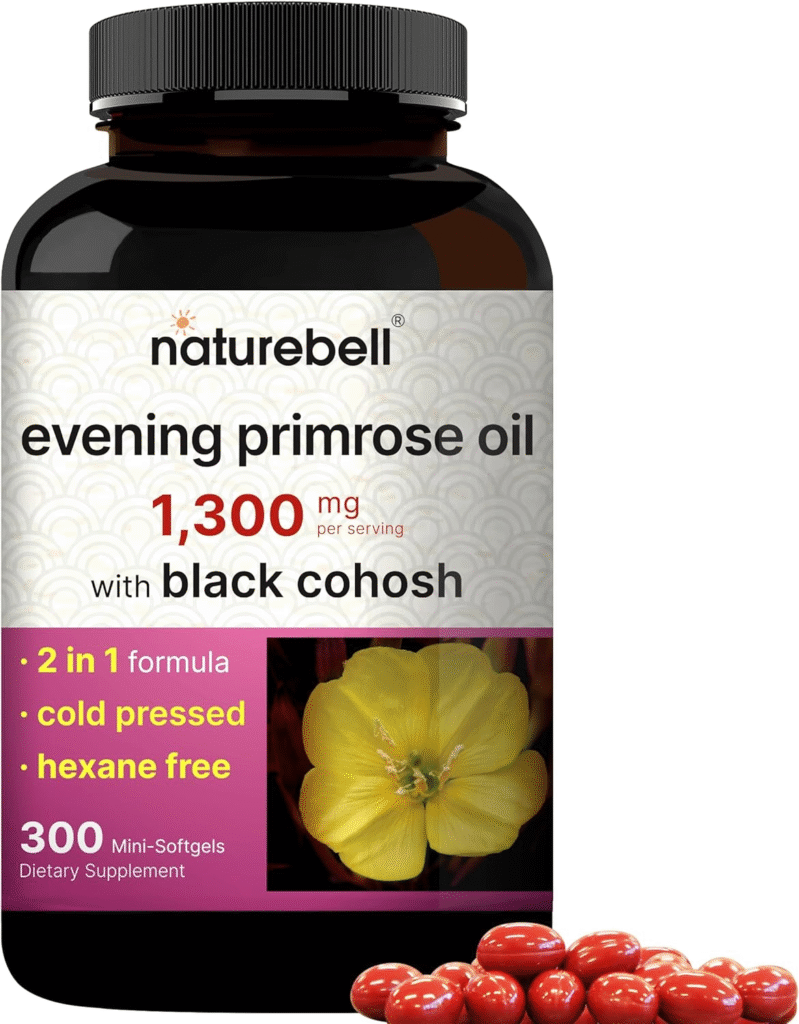
Squalane Oil
Derived from olives, squalane is incredibly moisturizing and helps to reduce the appearance of fine lines and wrinkles. It’s lightweight and easily absorbed, making it an excellent choice for those who prefer a less greasy feel.
Try this product from Amazon: QRxLabs Pure Organic Squalane Oil
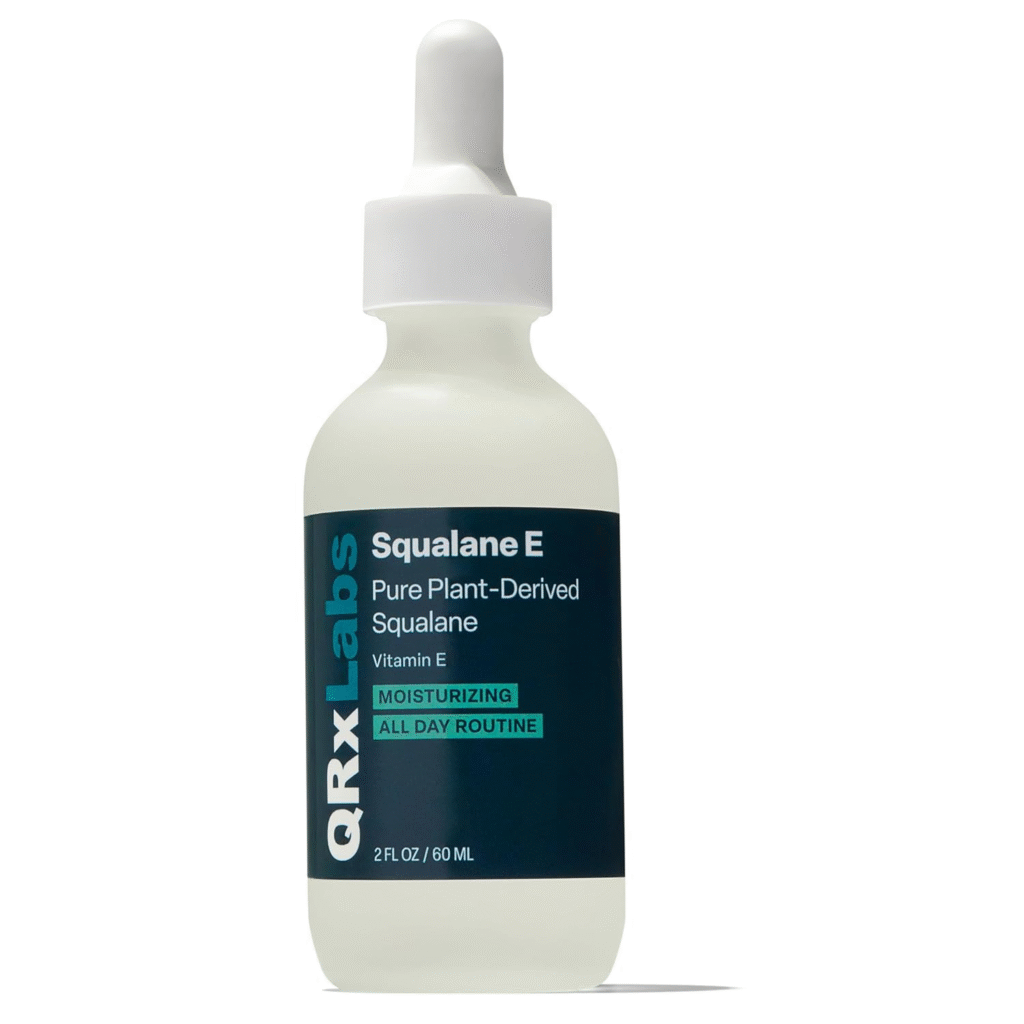
Adding Essential Oils
Essential oils add a pleasant aroma to your blend and provide extra skincare benefits. However, they’re potent and should be used sparingly.
Here are some essential oils that work well for menopausal skin:
Frankincense
Known for its ability to promote cell regeneration and reduce the appearance of age spots and fine lines. It also has a grounding, calming scent that can help reduce stress.
Try this product from Amazon: Kukka Frankincense Essential Oil for Face & Skin
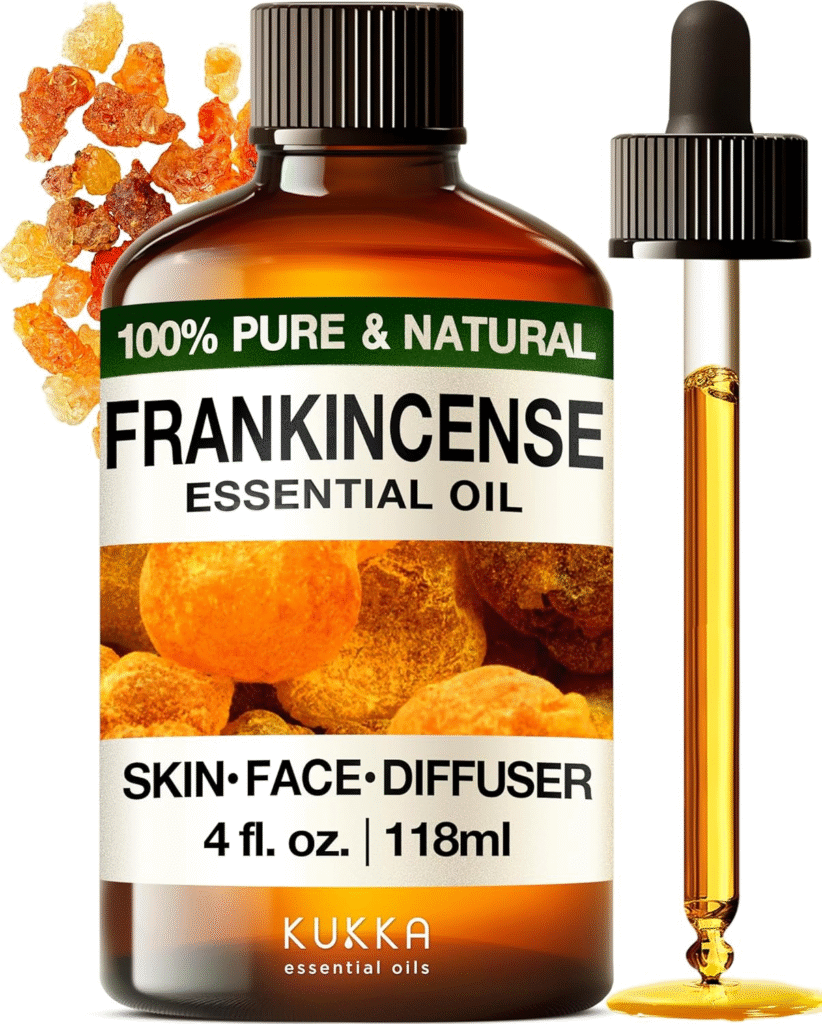
Face & Skin
Geranium
Helps balance oil production and has a soothing effect on the skin. Its floral scent is also known to help balance hormones and reduce stress.
Try this product from Amazon: EVOKE OCCU Pure & Natural Geranium Essential Oil
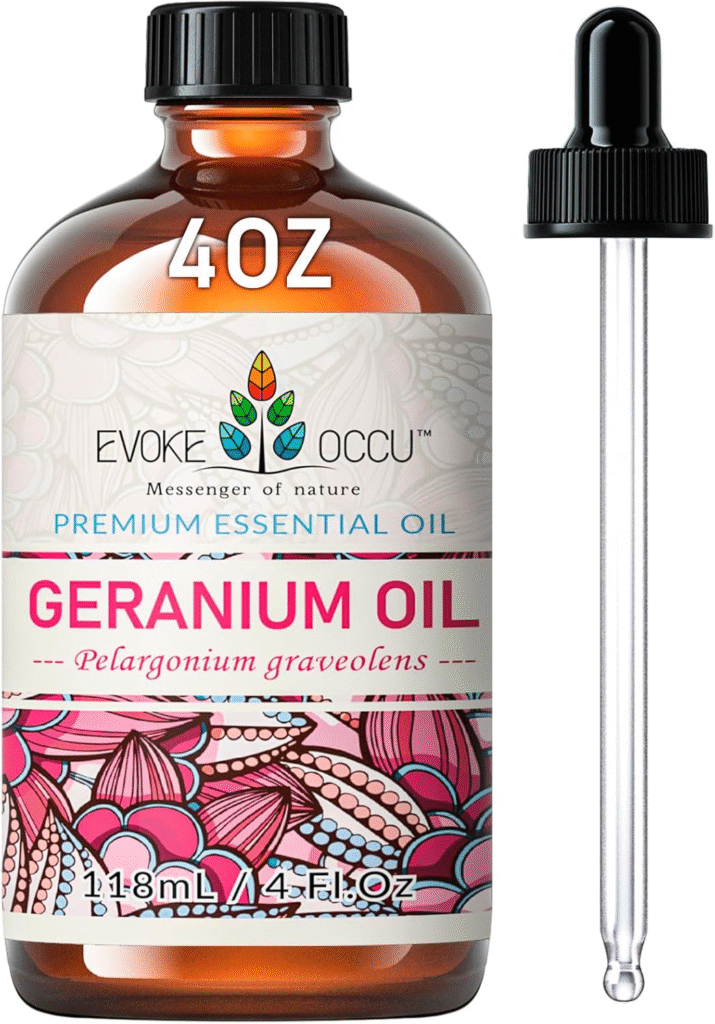
Lavender
Calming and anti-inflammatory, it can help soothe irritated skin. Lavender is also known for its ability to promote relaxation and better sleep, something many menopausal women struggle with.
Try this product from Amazon: US Organic 100% Pure Lavender Essential Oil
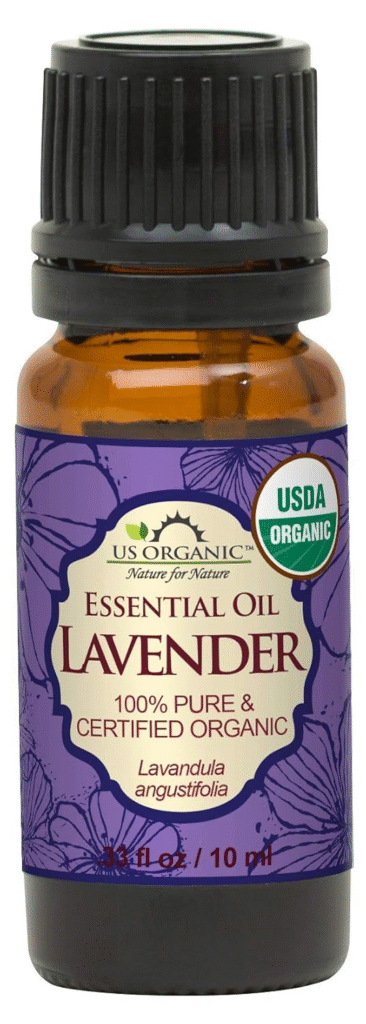
Rose
Hydrating and emotionally uplifting, rose oil can help improve skin texture and tone. It’s also known for its ability to balance hormones and reduce the appearance of broken capillaries.
Try this product from Amazon: Yoken Rosehip Seed Oil
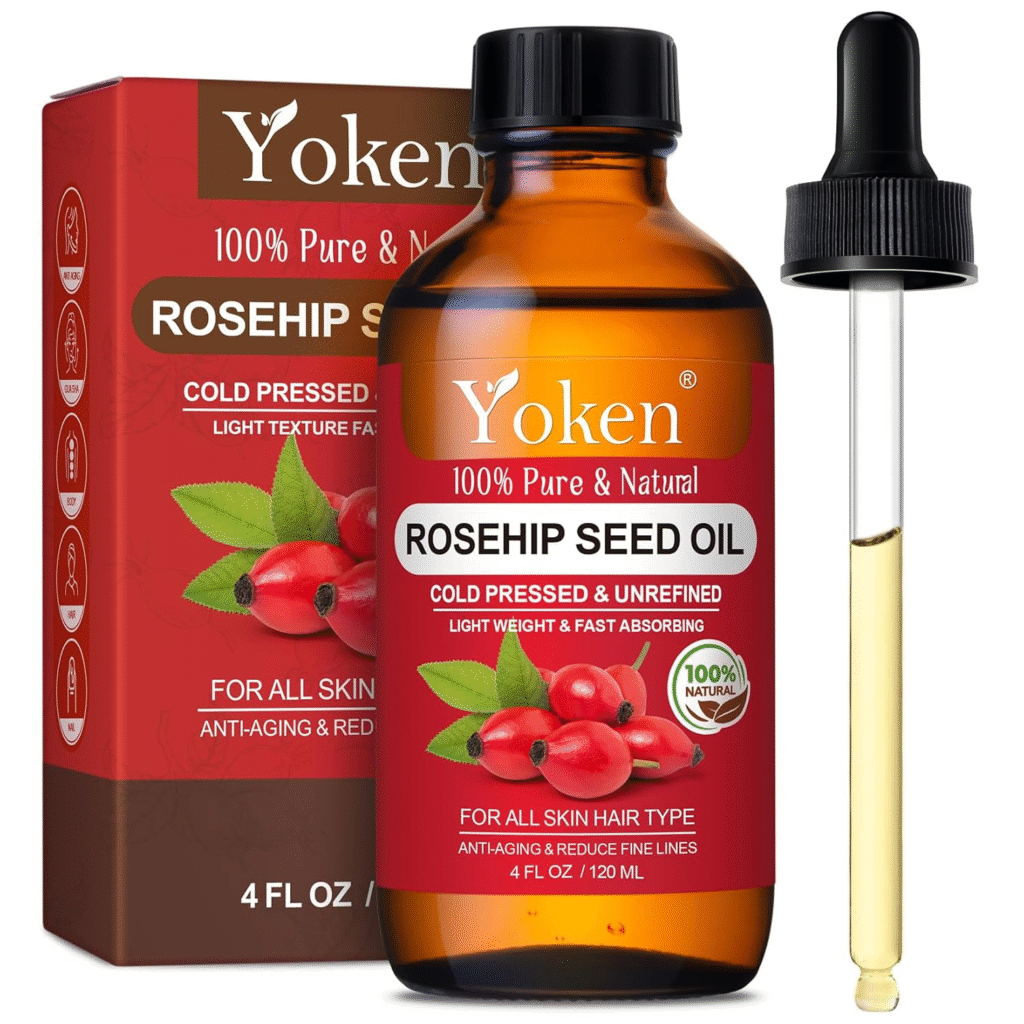
Clary Sage
Often used to help balance hormones and reduce the appearance of wrinkles. Its earthy, herbaceous scent is also known to help reduce hot flashes and night sweats.
Try this product from Amazon: H’ana Clary Sage Essential Oil
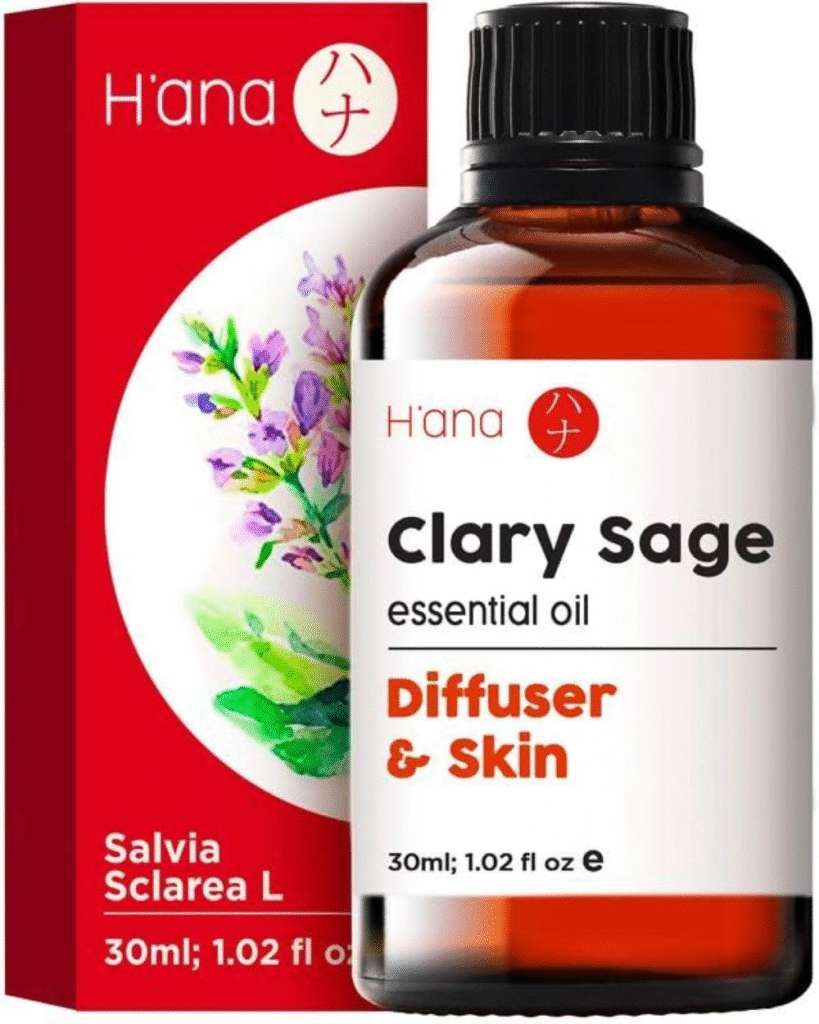
Creating Your Custom Blend
Now that we’ve covered the basics, let’s create a facial oil blend tailored for menopausal skin. Here’s a simple recipe to get you started:
Ingredients:
- 1 oz (30 ml) Jojoba Oil
- 1/2 oz (15 ml) Rosehip Seed Oil
- 1/2 oz (15 ml) Argan Oil
- 5 drops Frankincense Essential Oil
- 3 drops Geranium Essential Oil
- 2 drops Lavender Essential Oil
Instructions:
- In a clean, dark glass bottle, mix the jojoba oil, rosehip seed oil, and argan oil.
- Add the essential oils drop by drop.
- Gently roll the bottle between your hands to mix the oils together.
- Label your bottle with the ingredients and date of creation.
Application Tips
To get the most out of your custom facial oil, follow these application tips:
- Cleanse your face thoroughly before applying the oil.
- While your skin is still slightly damp, place 4-6 drops of oil in the palm of your hand.
- Gently press the oil into your skin, as opposed to rubbing it in.
- Pay extra attention to areas that tend to be drier or show more signs of aging.
- Use gentle upward motions to promote lymphatic drainage and boost circulation.
- Allow the oil to absorb for a few minutes before applying any other products.
Pro Tip: For an extra boost of hydration, mix a drop or two of your facial oil into your regular moisturizer.
Customizing Your Blend
As you become more familiar with facial oils, don’t be afraid to experiment and adjust your blend. You might find that your skin responds particularly well to certain oils, or you may want to address specific concerns.
For example, if you’re dealing with menopausal acne, you might want to add a few drops of tea tree oil to your blend for its antibacterial properties. If you’re struggling with hyperpigmentation, consider adding a bit of carrot seed oil, which is known for its ability to even out skin tone.
Keep a journal of the blends you try and how your skin reacts to help you fine-tune your perfect formula. Skincare is personal, and what works best for you may change over time.
Storage and Shelf Life
To confirm your facial oil stays fresh and effective:
- Store it in a cool, dark place away from direct sunlight.
- Use dark glass bottles to protect the oils from light degradation.
- Keep track of when you made your blend – most facial oils will stay fresh for about 6 months.
- If you notice any changes in smell or appearance, it’s time to make a new batch.
The Holistic Approach
A custom facial oil can work wonders for your skin, but it’s just one part of a holistic approach to skincare during menopause. Combine your oil use with a healthy diet rich in antioxidants, plenty of water, regular exercise, and stress-reduction techniques for the best results.
As you mix your oils and apply them to your skin, take a moment to appreciate your body and all it’s been through. Embrace the changes that come with menopause and nourish your skin with the natural goodness of these carefully selected oils.
Potential Challenges and Solutions
While facial oils are generally useful, some people may experience challenges when incorporating them into their skincare routine. Here are a few common issues and how to address them:
Greasiness
If your skin feels too greasy after applying the oil, you may be using too much. Start with just a few drops and increase gradually as needed. You can also try applying the oil to damp skin, which can help it absorb more quickly.
Breakouts
If you’re experiencing breakouts, your blend may be too heavy for your skin. Try reducing the amount of heavier oils like avocado or coconut, and increase lighter oils like grapeseed or jojoba. You might also consider adding a drop or two of tea tree oil for its antibacterial properties.
Sensitivity
If you experience irritation, it may be because of the essential oils. Try a blend without essential oils, or reduce the amount used. You can also patch test new oils on a small area of skin before incorporating them into your full facial routine.
Uneven Application
If you’re finding it difficult to apply the oil evenly, try mixing a few drops with your regular moisturizer for easier application. You can also try warming the oil between your palms before applying, which can help it spread more easily.
It may take some time for your skin to adjust to the new routine. Give it at least a few weeks before making any major changes to your blend.
Advanced Techniques
Once you’ve mastered the basics of creating and using facial oils, you might want to explore some advanced techniques:
Layering
Try applying different oils in layers. For example, start with a light oil like jojoba, followed by a more nourishing oil like rosehip.
This can allow you to target different skin concerns with each layer.
Seasonal Adjustments
Consider changing your blend with the seasons. You might prefer a lighter blend in summer and a richer one in winter.
Pay attention to how your skin’s needs change throughout the year and adjust accordingly.
Targeted Treatments
Create separate blends for different areas of your face. For example, a richer blend for dry cheeks and a lighter one for your T-zone.
This allows you to address multiple skin concerns simultaneously.
Oil Cleansing
Explore the oil cleansing method, which uses oils to cleanse the skin instead of traditional cleansers. This can be particularly beneficial for dry, menopausal skin as it cleanses without stripping the skin of its natural oils.
Facial Massage
Learn facial massage techniques to enhance the absorption and benefits of your oils while promoting lymphatic drainage and relaxation. This can also help improve circulation and give your skin a healthy glow.
The Science Behind Facial Oils
Understanding the science behind facial oils can help you appreciate their benefits and choose the right ones for your skin. Here’s a deeper dive into how they work:
Lipid Barrier Support
Our skin has a natural lipid barrier that helps retain moisture and protect against environmental stressors. As we age, especially during menopause, this barrier can become compromised. Facial oils help replenish and support this barrier, mimicking the skin’s natural lipids.
Occlusive Properties
Many oils have occlusive properties, meaning they form a protective layer on the skin that helps prevent moisture loss. This is particularly beneficial for menopausal skin, which tends to be drier.
Antioxidant Protection
Many plant oils are rich in antioxidants like vitamin E, which help protect the skin from free radical damage. This can help slow down the aging process and protect against environmental stressors.
Anti-Inflammatory Effects
Certain oils, like chamomile and blue tansy, have potent anti-inflammatory properties. This can help soothe irritated skin and reduce redness, which is common in menopausal skin.
Nutrient Delivery
Oils can act as carriers for other beneficial ingredients, helping them penetrate deeper into the skin. This makes them an excellent vehicle for delivering vitamins and other nutrients to the skin.
Incorporating Facial Oils into Your Routine
To get the most out of your custom facial oil, it’s important to incorporate it correctly into your skincare routine. Here’s a suggested order of application:
- Cleanse your face thoroughly.
- Apply any water-based serums or treatments.
- While your skin is still slightly damp, apply your facial oil.
- If needed, follow with a moisturizer to seal everything in.
- During the day, always finish with a broad-spectrum sunscreen.
A little goes a long way with facial oils. Start with just a few drops and adjust as needed.
The Emotional Benefits of Facial Oils
Beyond their physical benefits, using facial oils can have emotional and psychological benefits as well. The act of massaging oil into your skin can be a form of self-care and mindfulness, helping to reduce stress and promote relaxation.
The aromatherapeutic properties of essential oils can also have mood-boosting effects. For example, lavender can promote relaxation, while citrus oils can be uplifting and energizing.
Taking the time to care for your skin with natural, nourishing oils can also help boost self-confidence and promote a positive body image during a time of significant change.
Frequently Asked Questions
What are the best oils for menopausal skin?
Some of the best oils for menopausal skin include jojoba oil, rosehip seed oil, argan oil, and evening primrose oil. These oils are rich in nutrients that help hydrate, nourish, and protect aging skin.
Can facial oils help with menopausal acne?
Yes, certain facial oils can help with menopausal acne. Tea tree oil has antibacterial properties, while jojoba oil can help balance oil production.
However, it’s important to choose non-comedogenic oils and use them in moderation.
How often should I use facial oil on menopausal skin?
Most people can benefit from using facial oil once or twice daily. However, the frequency may vary depending on your skin type and specific needs. Start with once a day and adjust as needed.
Can facial oils replace moisturizer?
While facial oils are highly moisturizing, they may not be enough for everyone, especially those with very dry skin. Some people find that using both a facial oil and a moisturizer provides the best results.
Are essential oils safe for sensitive menopausal skin?
Essential oils can be useful, but they’re also potent and may irritate sensitive skin. If you have sensitive skin, start with a very small amount of essential oil in your blend, or consider using them in a diffuser instead of directly on your skin.
How long does it take to see results from using facial oils?
Results can vary, but many people notice improved hydration and a healthier glow within a few days of starting to use facial oils. More significant improvements in skin texture and appearance may take several weeks to become noticeable.
Can facial oils help with menopausal hot flashes?
While facial oils aren’t a cure for hot flashes, certain essential oils like clary sage and peppermint may help provide a cooling sensation when applied to the skin. However, it’s important to address hot flashes holistically, including lifestyle changes and potentially medical interventions.
Is it normal for facial oil to feel greasy at first?
It’s common for facial oil to feel a bit greasy when first applied, especially if you’re not used to using oils. This feeling should subside as the oil absorbs into your skin. If it continues, you may be using too much oil or a blend that’s too heavy for your skin type.
Can I make a larger batch of facial oil to use over time?
Yes, you can make a larger batch of facial oil to use over time. However, keep in mind that natural oils can go rancid.
It’s best to make only as much as you can use within 3-6 months and store it properly in a cool, dark place.
How do I know if a facial oil is right for my skin?
The best way to determine if a facial oil is right for your skin is to patch test it first. Apply a small amount to a discreet area of your face and observe for any reactions over 24-48 hours.
If there’s no irritation, you can likely use it safely on your entire face.
Key Takeaways:
- Facial oils are excellent for addressing the unique needs of menopausal skin.
- Choose carrier oils like jojoba, rosehip, and argan as your base.
- Add essential oils for extra benefits and a pleasant aroma.
- Customize your blend to suit your specific skin concerns.
- Apply facial oil to damp skin using gentle, upward motions.
- Store your blend properly and replace it every 6 months.
Disclaimer
The information contained in this post is for general information purposes only. The information is provided by DIY: Create Your Own Facial Oil for Menopausal Skin and while we endeavor to keep the information up to date and correct, we make no representations or warranties of any kind, express or implied, about the completeness, accuracy, reliability, suitability or availability with respect to the website or the information, products, services, or related graphics contained on the post for any purpose.


